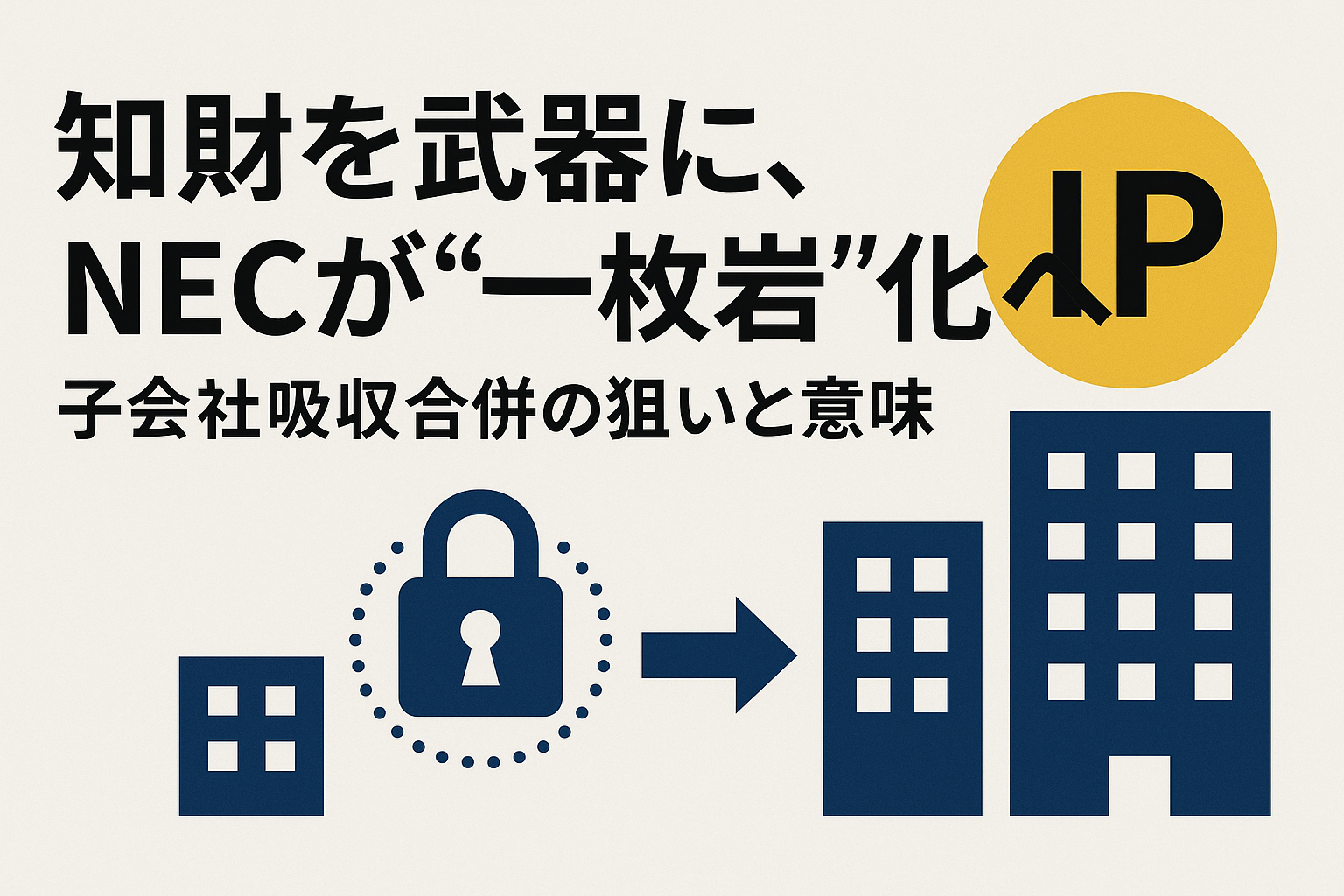On October 21, NEC announced that it would absorb its wholly owned subsidiary, Nippon Electric Patent and Technology Information Center—responsible for IP support and patent analysis—into NEC’s Intellectual Property & Rulemaking Division (effective April 1, 2026).
This reorganization signals NEC’s growing emphasis on intellectual property (IP) as a core management resource, aimed at accelerating strategies such as “expanding its IP portfolio” and “strengthening IP licensing revenue.”
This article examines the move from four perspectives: background, objectives, risks, and future outlook.
Background: Why integrate IP now?
The rising value of IP
NEC has built strengths in cutting-edge technologies such as facial recognition and AI, placing importance on the flow from “technology → patent → license.”
The company also seeks to expand IP licensing revenue from both startups and major corporations, positioning IP not only as a means of “defense” but also as an “offensive” source of income.
Across Japanese industry as a whole, the importance of IP management and utilization is increasing amid global competition, technology outflow risks, digitalization, and the rise of AI.
Challenges in organizational efficiency
By integrating its previously separate IP support and management subsidiary into the parent company, NEC aims to eliminate duplication, coordination inefficiencies, and slow decision-making.
Under the company’s policy of “placing IP at the core of management,” this internal integration represents a concrete step toward that goal.
Strategic positioning
NEC reportedly targets ¥300 billion in business value by FY2025 and aims in its next mid-term plan to achieve “10% of company-wide profit from IP licensing and related revenue.”
If IP can be monetized effectively, NEC can add “stock-type” revenue from IP licensing on top of its traditional product and service sales.
Objectives: What does this merger aim to achieve?
One-stop and accelerated IP operations
By consolidating IP support, patenting, management, and analysis functions into the Intellectual Property & Rulemaking Division, NEC can enhance inter-departmental collaboration and speed up decision-making.
In particular, placing “information intelligence” functions—such as technology trend and competitor IP analysis—closer to decision-makers enables tighter integration of technology, IP, and business strategies.
Enhanced external utilization and monetization of IP
NEC focuses on advanced technology patents and licensing. Through integration, it seeks to strengthen its capabilities in IP licensing, contract negotiation, external deployment, and startup support.
This aims to accelerate the shift of IP from a “cost center” to a “revenue-generating asset.”
Optimization of management resources and cost reduction
Maintaining the subsidiary would lead to inefficiencies—duplicated administrative functions, coordination costs, and complex reporting flows. The merger aims to reduce these indirect costs and streamline fixed and administrative expenses related to IP operations.
Although NEC describes the impact as “minor,” reorganizing these invisible costs carries strategic significance.
Preparing for future business model transformation
In frontier fields such as facial recognition, AI, and drug discovery, NEC must evolve beyond the traditional “hardware + software + services” model toward IP-driven platform and ecosystem models.
By reinforcing and internalizing its IP function, NEC is preparing to respond quickly to new business models such as licensing, cross-licensing, joint development, and startup collaboration.
Risks and caveats
While integration offers many benefits, several potential risks must be considered:
Risk of a “formality-only” merger
If operational collaboration, cultural alignment, and system design do not follow structural integration, the outcome may remain fragmented.
Quality of the IP portfolio
Expanding licensing revenue requires not just patent filings but also strategic portfolio design encompassing overseas expansion, competitive positioning, and defensive use.
Regulatory and competitive shifts
IP value fluctuates with changes in laws, regulations, and standards—particularly in AI and data-related fields still under legal development.
Time lag to monetization
IP licensing takes time—technology must be implemented, adopted, and contracted—so the short-term business impact will likely be limited.
Human and cultural integration challenges
IP professionals (patent attorneys, analysts, negotiators) have highly specialized expertise, and blending subsidiary and parent company cultures—speed, cross-functional collaboration, and business focus—may prove difficult.
Future outlook: What to watch for
Progress in IP licensing revenue
How NEC’s goal of “10% of corporate profit from IP-related revenue” is quantified and achieved will be a key indicator in the next mid-term plan.
Portfolio evolution
The focus areas—facial recognition, AI, drug discovery, data/IoT—where patenting and licensing will be intensified should become clearer after integration.
Startup ecosystem collaboration
NEC’s approach to leveraging external ecosystems through IP provision, partnerships, and licensing agreements will be critical.
Global expansion
As IP transcends borders, NEC’s overseas patent strategies, licensing negotiations, and competitive positioning warrant attention.
Legal and standardization response
The company’s adaptation to evolving IP systems, standards, and regulations in AI, data, and biotech fields will determine its future advantage.
Practical effectiveness of integration
Organizational consolidation is merely a means; the real test lies in how quickly, appropriately, and organically the new structure functions. Close attention should be paid to its operations, personnel deployment, and system readiness.
Conclusion
NEC’s merger with its IP subsidiary is more than just a “corporate restructuring.” It reflects a strategic intent to reposition intellectual property as a core management asset and to unify technology, IP, and business models.
The company’s goal is to shift IP from “defense” to “offense and monetization,” extracting value faster and more effectively.
However, realizing this potential will depend on execution—operational integration, cultural cohesion, and responsiveness to global and legal dynamics.
In an era when the ability to leverage IP defines corporate survival, NEC’s move may become a defining case in Japan’s evolving IP landscape.

